#kenya international trade exhibition
Text
Kenya International Trade Exhibition | Siora Surgicals

Kenya International Trade Exhibition will be going live at the Diamond Jubilee Expo Center, Dar es Salaam – Tanzania, from 9-11 October 2024. It is Africa’s premier medical exhibition that will showcase advanced healthcare technology and products. The aim of the 25th Medexpo Tanzania 2024 is to bring global healthcare experts to Africa and connect the African healthcare community with the rest of the world.
#medical exhibition medexpo africa#MEDEXPO AFRICA#Medexpo Tanzania 2024#MEDEXPO KENYA 2024#25th medexpo tanzania 2024#Tanzania MEDEXPO 2024#Tanzania premier medical exhibition#kenya international trade exhibition
0 notes
Text
Kenya to host the 11th International Flower Trade Exhibition attracting buyers from over 75 countries
Kenya set to host the global flower trade fraternity in Nairobi, June 4-6 2024 stamping the country’s growing dominance in the sector.
Left to right: Dick Van Raamsdonk, General Director, HPP Exhibitions, Clement Tulezi, CEO, Kenya Flower Council and Christine Chesaro, Director, Horticultural Crop Directorate during the media briefing on the status of the Kenyan flower industry.
Kenya is once…

View On WordPress
0 notes
Text
Passion Fruit Market Dynamics: A Global Perspective
The passion fruit market is a vibrant and complex sector of the global agricultural economy, characterized by its wide variety of species, fluctuating prices, and diverse geographical distribution. This report provides an in-depth analysis of the current state of passion fruit trading and market prices around the world as of March 2024, offering insights into the challenges and opportunities faced by producers, traders, and consumers alike.

Overview of Global Passion Fruit Prices
In March 2024, the passion fruit market exhibited a broad spectrum of prices across different regions, reflecting the intricate interplay between local supply conditions, demand levels, import tariffs, and transportation costs. Notably, prices ranged from as low as 1400 RWF per kilogram in Rwanda's Kimironko market to as high as 95 CNY per kilogram for improved species in Taiwan's Chiayi City Market. This variation underscores the significant impact of regional factors on passion fruit pricing.
European Market
In Europe, the price for passion fruit shows considerable variance. Spain's Mercatenerife market reported stable prices at 4 EUR per kilogram, indicative of a steady supply-demand equilibrium. Conversely, the Lyon-Corbas market in France highlighted a price range for Colombian passion fruit between 7.5 and 7.8 EUR per kilogram, reflecting the premium on imported varieties. The import market, such as MIN Nantes in France, saw prices ranging from 11.3 to 15 EUR per kilogram, emphasizing the added costs associated with bringing exotic fruits to European consumers.
African Insights
Africa, particularly the eastern and southern regions, plays a critical role in the passion fruit market, both as a producer and a consumer. Rwanda's market offers one of the lowest global prices, indicating a strong local production. Kenya's ATF Greens Limited, pricing its Black and Yellow passion fruit varieties at 125 KSH for 500 grams, showcases the diversity within the African market and the specific valuation of different passion fruit types.
Asian Market Trends
In Asia, China's market illustrates the wide price range for passion fruit, from 7 to 8 CNY per 0.60 kg at the Suzhou Nan Huan Bridge Market to up to 95 CNY per kilogram for superior species at the Chiayi City Market. This price disparity highlights the significant influence of quality, variety, and consumer preference on pricing in the Asian markets.
Latin American Variations
Latin America, the origin of passion fruit, displays a wide array of prices influenced by local production, export capabilities, and market demand. Colombia's market, for example, ranges from 3500 COP per kilogram for Gulupa in Medellín to more competitive rates for bulk purchases, illustrating the nuanced dynamics of local versus export market pricing.
The Role of Import Markets
Import markets in the UK and North America reflect the global demand for passion fruit, translating into premium pricing for the fruit. George Perry Ltd. in the UK offers passion fruit at 15 GBP for approximately 3 kg, indicative of the higher costs associated with importing and distributing exotic fruits in regions where they are not locally produced.
Conclusion: Navigating the Passion Fruit Market
The global passion fruit market in 2024 is marked by its diversity, with pricing and availability influenced by a myriad of factors ranging from agricultural practices and climate conditions to international trade policies and consumer tastes. For stakeholders in the passion fruit supply chain, understanding these dynamics is crucial for making informed decisions, whether in production, trading, or retail. As the market continues to evolve, staying abreast of global trends, regional variations, and emerging opportunities will be key to success in the ever-changing landscape of passion fruit trading.
0 notes
Text
Analyze current market trends in the Kenyan marble industry and provide insights into its prospects.
The Kenyan marble industry has witnessed remarkable growth and transformation in recent years. With its unique range of marble varieties, the industry has gained both domestic and international recognition. In this article, we will analyze the current market trends in the Kenyan marble industry and provide insights into its prospects.
Current Market Trends
1. Export Growth
One of the most significant trends in the Kenyan marble industry is the impressive growth in exports. Kenyan marble, known for its quality and aesthetic appeal, has found a place in international markets. Countries in Europe, Asia, and the Middle East have shown a growing appetite for Marble Manufacturer in Kenya. This export trend has not only increased revenue for manufacturers but has also boosted the country's economy.
2. Sustainability and Eco-Friendly Practices
In recent years, there has been a notable shift towards sustainability in the Kenyan marble industry. Manufacturers are increasingly adopting eco-friendly practices in quarrying and processing. They are investing in technologies that reduce energy consumption and water usage, and they prioritize reforestation and habitat preservation in quarry areas. This commitment to sustainability aligns with global trends and attracts environmentally-conscious customers.
3. Artisanal Craftsmanship
Kenyan marble manufacturing has a strong connection with local artisans and craftsmen. This trend is gaining prominence as consumers seek unique, handcrafted marble products. Skilled artisans play a vital role in creating custom designs and adding artistic value to the finished products. Their work not only preserves traditional craftsmanship but also enhances the industry's reputation for quality.
4. Technological Advancements
Advancements in technology have revolutionized the Kenyan marble industry. From cutting and polishing to quality control, manufacturers are increasingly relying on cutting-edge machinery and automation. This not only improves efficiency but also ensures consistent quality. Moreover, technological innovations have opened up new design possibilities, allowing manufacturers to meet the diverse demands of the market.
5. Investment in Marketing and Promotion
Marble Manufacturer in Kenya are realizing the importance of effective marketing and promotion. They are actively participating in international trade fairs, exhibitions, and marketing campaigns to showcase their products to a global audience. This trend is helping them establish their brand presence and expand their customer base.
Future Prospects
1. Diversification of Product Range
The future of the Kenyan marble industry lies in diversifying its product range. While traditional marble products like tiles, slabs, and sculptures will continue to be popular, manufacturers can explore new possibilities. This includes developing innovative products such as marble furniture, home décor, and even fashion accessories. Diversification can open up new revenue streams and cater to changing consumer preferences.
2. Expansion of Export Markets
The growing demand for Marble Manufacturer in Kenya in international markets presents a significant growth opportunity. To capitalize on this, manufacturers should focus on expanding their export markets. This could involve establishing distribution networks, partnering with international retailers, and adapting products to meet the specific requirements of different regions.
3. Sustainable Practices as a Competitive Advantage
As global environmental concerns intensify, sustainability will become a competitive advantage for Kenyan marble manufacturers. Those who invest in eco-friendly practices, obtain certification and transparently communicate their sustainability efforts will gain a competitive edge in the market. They can attract environmentally-conscious consumers and meet the sustainability requirements of international buyers.
4. Collaborations and Partnerships
Collaborations and partnerships, both within the industry and with international players, hold promise for the Kenyan marble industry. Collaborative ventures can facilitate technology transfer, knowledge sharing, and joint marketing efforts. These partnerships can help manufacturer’s access new markets and stay at the forefront of industry innovations.
5. Infrastructure Development
Investment in infrastructure, including modern quarries and processing facilities, is essential for the future growth of the Kenyan marble industry. Improved infrastructure not only increases production efficiency but also enhances the quality of finished products. It also makes the industry more attractive to potential investors.
6. Government Support and Policies
The Kenyan government's support and policies will play a crucial role in shaping the future of the marble industry. The government can provide incentives for sustainable practices, offer financial assistance for technology upgrades, and streamline export procedures. Clear and supportive policies can create a conducive environment for industry growth.
Preserving Kenya's Marble Heritage
Marble, with its timeless beauty and enduring quality, has played a significant role in Kenya's architectural and cultural heritage. From historic structures to intricate sculptures, the use of marble in Kenya dates back centuries, reflecting the country's rich history and artistic traditions. However, as the years go by, the preservation of Kenya's marble heritage becomes increasingly important.

Historical Significance
Kenya's marble heritage is a testament to its historical and cultural roots. Many historical buildings and monuments in Kenya feature marble elements that tell the story of the country's past. For instance, the iconic Mausoleum of Jomo Kenyatta, the first President of Kenya, prominently displays white marble. This monument not only commemorates a key figure in Kenya's history but also serves as a symbol of national pride.
Architectural Marvels
Marble has been used in the construction of some of Kenya's most impressive architectural marvels. The All Saints' Cathedral in Nairobi, known for its stunning neo-Gothic design, features marble floors, columns, and intricate carvings. The use of marble in such structures not only adds to their aesthetic appeal but also ensures their durability and longevity.
Cultural Artifacts
Beyond architecture, marble has been used to create intricate sculptures and cultural artifacts. These sculptures often depict traditional African themes and symbols, showcasing the fusion of classical artistry with indigenous culture. Preserving these sculptures is not only important for artistic appreciation but also for understanding Kenya's diverse cultural heritage.
Challenges to Preservation
Preserving Kenya's marble heritage is not without its challenges. Several factors pose a threat to the longevity and integrity of marble structures and sculptures:
Environmental Factors: Kenya's climate can be harsh on marble, with factors like extreme heat, humidity, and pollution contributing to the erosion and deterioration of marble surfaces over time.
Vandalism and Theft: Cultural artifacts made of marble are susceptible to vandalism and theft. Illicit trade in valuable marble sculptures can lead to the loss of irreplaceable pieces of heritage.
Lack of Maintenance: Due to financial constraints and limited resources, some marble structures have not received the necessary maintenance and conservation efforts, accelerating their decay.
Preservation Efforts
Efforts to preserve Kenya's marble heritage are essential to safeguard these valuable cultural assets for future generations:
Conservation and Restoration: Preservation efforts often involve the careful conservation and restoration of marble structures and sculptures. This includes cleaning, repairing, and protecting the marble to prevent further deterioration.
Security Measures: Implementing security measures at historical sites and museums is crucial to deter vandalism and theft. Surveillance systems and vigilant security personnel can help protect valuable marble artifacts.
Public Awareness: Raising public awareness about the significance of Kenya's marble heritage is vital. Education campaigns and outreach programs can instill a sense of pride and responsibility among the local population to protect these treasures.
Collaboration: Collaboration between government agencies, cultural organizations, and international partners can pool resources and expertise for preservation projects. Such collaborations can lead to more comprehensive and effective preservation efforts.
Technological Advancements: Embracing modern technologies for conservation, such as advanced cleaning methods and protective coatings, can extend the life of marble structures and sculptures.
Preservation Benefits
Preserving Kenya's marble heritage offers several significant benefits:
Cultural Identity: Preserving marble heritage reinforces Kenya's cultural identity and highlights the nation's rich history and artistic achievements.
Tourism and Economy: Well-preserved marble structures and sculptures attract tourists, contributing to the tourism sector and the economy as a whole.
Education and Research: These preserved artifacts provide valuable resources for education and research, allowing scholars and students to study Kenya's history and culture.
Community Engagement: Preservation projects can engage local communities, providing employment opportunities and fostering a sense of pride and ownership.
Conclusion
The Marble Manufacturer in Kenya has made significant strides in recent years, and its prospects appear promising. With a focus on sustainability, diversification, technological innovation, and global outreach, the industry is well-positioned to continue its growth trajectory. By seizing the opportunities presented by expanding export markets and embracing sustainable practices, Kenyan marble manufacturers can secure a prosperous future for the industry while contributing to the country's economic development.
0 notes
Photo










International Tea Day
International Tea Day is an annual feast celebrated on December 15. Is there anything that will make the snowy chill winter season into a warmer climate other than a cup of tea? Of course, nothing can stand in front of the tea, and no other beverages can make you feel the warmth. Tea is the most popular drink from all over the world and is usually served hot. Having a tea kettle in hand and sipping it would never be compensated by any other drink. International Tea Day is observed as to draw the attention of government and public about the problems besetting the tea production and how tea plantations, small tea growers and consumers are being affected by the global tea trade. Hence, it is not yet another Day to excuse yourself to have a cup of tea rather it is a Day to think about the problems faced by the tea plantation and the impacts of the global tea trade.
“Tea, though ridiculed by those who are naturally coarse in their nervous sensibilities will always be the favorite beverage of the intellectual.” – Thomas de Quincey
History of International Tea Day
In the year 2005, the International Tea Day was first observed. Since then, the Day is celebrated in the tea producing countries from all over the world. It includes Bangladesh, India, Indonesia, Kenya, Malaysia, Malawi, Nepal, Sri Lanka, Tanzania, Uganda, and Vietnam. Although the idea for establishing this Day existed for many years, it was not made into an action earlier to 2004. Once after the initial discussions held at the World Social Forum in 2004, the first observance of the International Tea Day was celebrated in New Delhi in the year 2005. It was organized in Sri Lanka in the following year and in 2008. The trade union movements have jointly organized the celebration Day and the related Global Tea Conferences.
International Tea Day aims in raising the global attention of governments and citizens about the impacts of the global tea trade. The Day also brings out the problems faced by the workers and growers. With the observance, the Day also aims in linking the requests for the price supports and fair trade. The impact of the global tea trade falls on the workers of the tea plantations, small producers and the consumers. The Indian government in 2015 had proposed expanding the observance of this Day through the UN Food and Agriculture Organization. With the World Trade Organization commodity policies, world trade in tea is beholding some significant changes. Under the compulsions of WTO, the structure of the global tea trade commodity provides an absolute advantage to both the transnational brands and the retailers in the trade.
With WTO compulsions, the elimination of tariff and importing tea from other countries would largely diminish the commodity rates of the tea in the producing countries. All these have made a situation where without increasing the demand for tea, global commodity prices have been pushed further downwards. As a result, tea gardens get abandoned. Thus enabling the global brands to purchase tea at the lowest possible prices. It is a perfect Day for anyone who loves tea to show your gratitude and appreciation to those people who are involved in planting, processing and delivering this excellent beverage to all the people globally.
How to Celebrate International Tea Day
Celebrating the International Tea Day is quite simple. Firstly you have to drink a cup of tea with your friends and family. You can add some ginger, cinnamon to make it tastier. Next, you can discuss the problems faced by the tea plantations, producers, and consumers. Participate in various exhibitions conducted by the ITD as a form of dedication to tea and gather useful information. You can even take a visit to the nearest hill station where tea is grown. Ask the people who are working there about their problems. Tell people around you about your visit to the tea plantation and the information you have gathered.
Source
#Peach Green Tea#Tropical Ice Tea#always unsweetened#I love tea#USA#my favorite tea is earl grey#Jack's Dundee Tea#food#original photography#Canada#don't drink and drive#Women are Persons By Barbara Patterson#Ottawa#International Tea Day#InternationalTeaDay#15 December#Spiked Texas Tea#Malaysian Ice Tea#Pineapple Black Tea#Lavender Ice Tea
4 notes
·
View notes
Text
The Future Is Now
I was wondering what is the next step of the Future Architecture at the Creative Exchange 2020 in Ljubljana’s MAO, during the launch of the 2020 European Architecture Program.
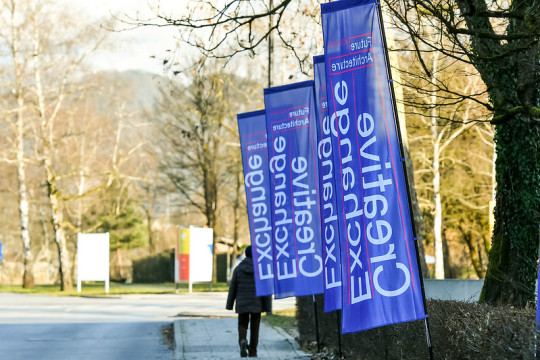
It includes a series of exhibitions, conferences, lecture series, workshops, summer schools, Archifutures publications in 12 cities around Europe.
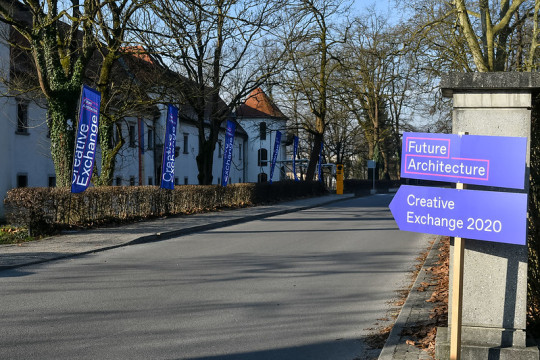
This year’s call for Ideas drew a record of 433 entries from 53 countries, mostly from social and environmental issues and also from technology and heritage.
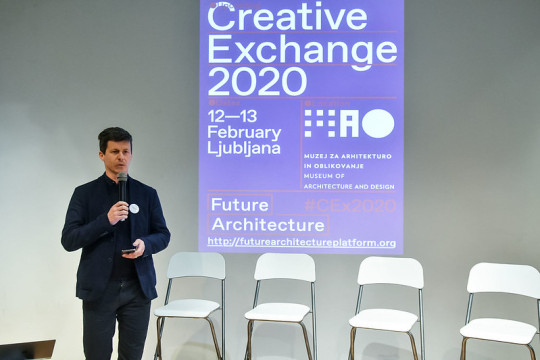
“There is nothing more important than thinking about the future,” says platform leader and director of MAO Matevž Čelik, “the coming generation of architecture professionals is clearly aware that the issue of the future of architecture is not a matter of yet another new building. They question everything, from how to establish new ways of practicing architecture alternative spatial relations, non-speculative housing models, open-source civic platforms for architecture and urban planning. They are developing tools to reactivate derelict spaces and awaken architectural activism in order to avoid the total breakdown of the climate and the environment.”
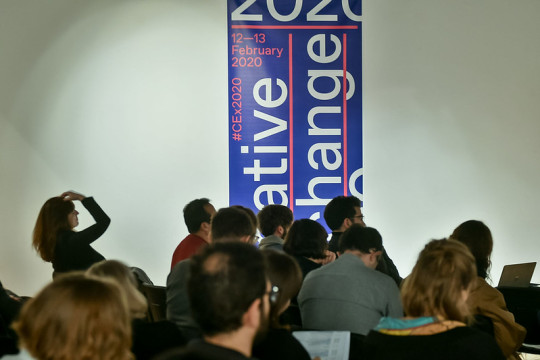
The Matchmaking conference featured 25 ideas that were selected and presented in five different panels Research, Storytelling, Architecture as Cultural Production, Strategies and Practice.
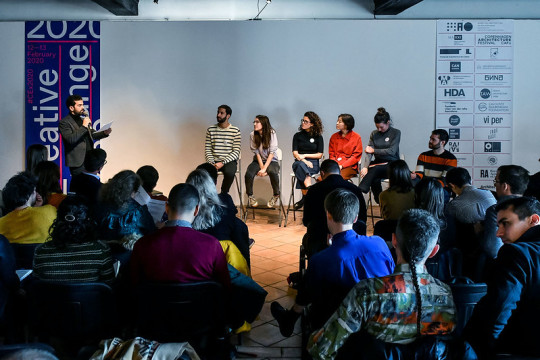
pais(vi)agem (Barcelona, Spain), Forty-Five Degrees (Berlin, Germany), Office of Human Resources (New York, USA), TiriLab (Thesprotias, Greece) and Institute for Linear Research (Triesen, Liechtenstein)
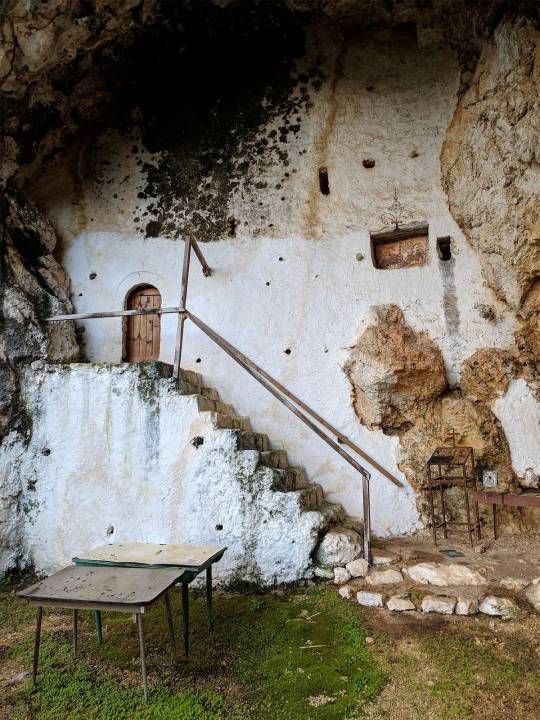
Mapping the Margins by Tirilab is a series of maps and documentations, identifying all the women associations, local agriculture cooperatives as well as abandoned buildings in Thesprotia province, in order to create an active platform where many cooperatives can find a space to grow.
vimeo
Agro Commune by Office of Human Resources investigates how small-scale local farmers in Kenya can take and learn from the cut-flower dominated Greenhouse colonies owned by foreign corporations, in order to create ecologically sustainable models.
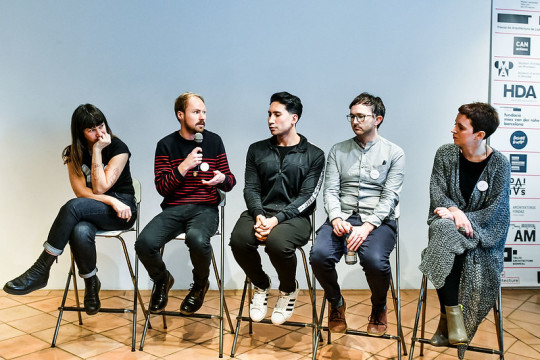
Armina Pilav from Un-war Space Lab (Mostar, Bosnia and Herzegovina), Grégoire Deberdt (Paris, France), Constantinos Marcou (Larnaca, Cyprus), Will Jennings (London, United Kingdom) and Sonja Lakić (Banja Luka, BIH).
vimeo
UN-war Space Lab from Mostar presented Neretva river recordings with the materiality of war and flowing memories filmed by Matija Kralj.
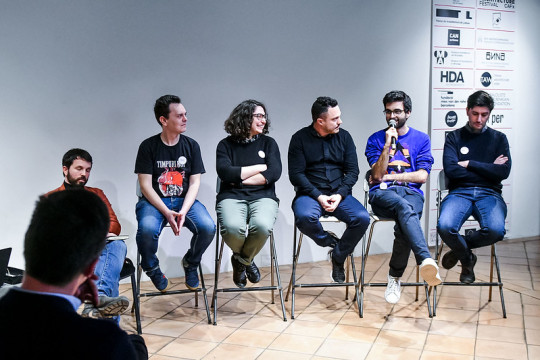
Unfolding Pavilion (Trento, Italy), Amigdala (Modena, Italy), Proyecto Colectivo (Baltimore, USA), Mies.TV (Vienna, Austria), Agustin Schang (Brooklyn, USA),
youtube
Unfolding Pavilion shared the experience of creating low-budget but high-impact exhibitions at Venice Biennale but outside the official schedule. The occupied space is never a gallery, but a building of outstanding architectural value, whose manifold relationships with its context is brought to the fore by the project. From using airbnb to trade offs with the local councils to use well-regarded social housing schemes and involved the residents – the team questions the money spent on official shows and whether the local population should be more involved.
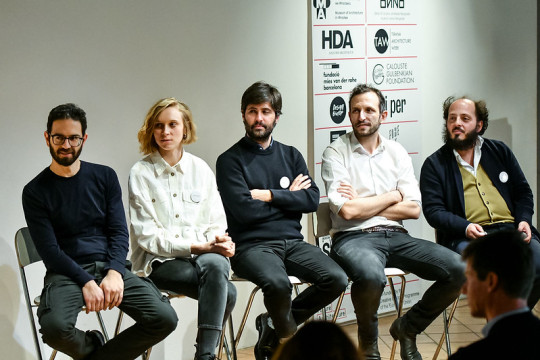
Renzo Sgolacchia (Rotterdam, Netherlands), Goda Verikaite (Rotterdam, Netherlands), Diego Sologuren, Brad Downey (Lausanne, Switzerland), TEN Studio & Alexis Kalagas (Australia), Architecture of Shame (Matera, Italy)
vimeo
The Distributed Cooperative by TEN Studio & Alexis Kalagas from Australia has created sophisticated digital planning tools that can pinpoint small sites that are available to be built on to create mixed-use cooperative housing developments. Tested in Zurich, the project is envisioned as updated model of sustainable shared living for the human-centered ‘smart city’ of the future.
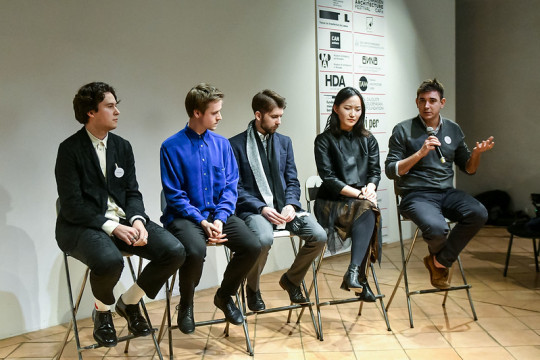
Critical Practice (London, UK), Jason Rhys Parry (Lafayette, USA), CIVIS (Cambridge, USA), Architects Climate Action Network (London, UK)

The Great Island of Replicas, an illustrated story by Constantinos Marcou, received an Honorable Mention at the 2019 Fairytales Blank Space Competition. Constantinous explains that "after the Great Explosion of many important parts of the planet, the cities were left floating in piles of sand, while only a few monuments survived. It’s been a few months since it was announced from the local authorities of Athens that the city has lost the temple of Parthenon. The whole world is still in terror and in search for what is behind this disappearance of unspeakable proportions... "
youtube
Why Does Beauty Matters? is an architecture backstage by Mies.TV, a global network of young people at the intersection of architecture and video. The documentaries focus on current themes which challenge the architecture profession and its environment.
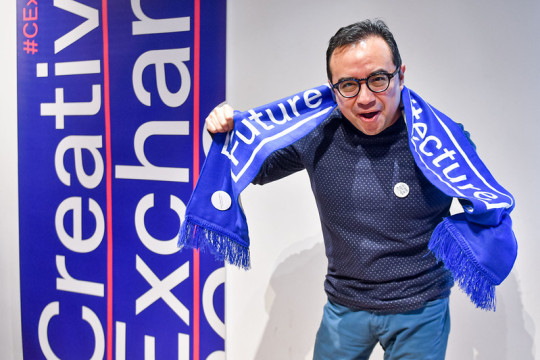
Monique Besten received the Writers Grant awarded by dpr-barcelona: “Books are louder than bombs!”
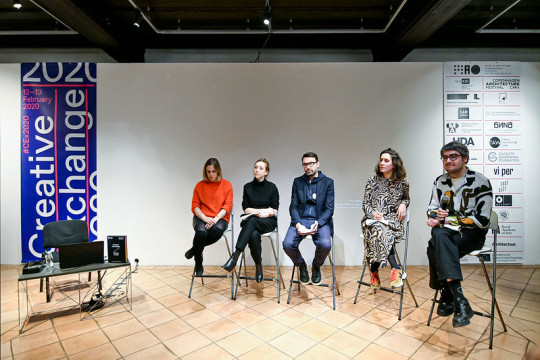
As part of the Creative Exchange there were several Focus Talks featuring international and leading architects as keynote speakers like James Taylor-Foster, writer, editor and curator of contemporary architecture and design at ArkDes in Stockholm; Mariana Pestana, architect and curator of the Istanbul Design Biennial; Marina Otero Verzier, architect and director of research at Het Nieuwe Instituut; Léa-Catherine Szacka, architect, historian and critic.
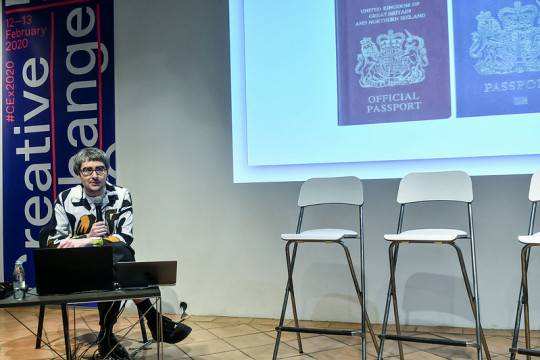
James described why the color of the UK passports will change after Brexit, becoming royal blue again. Thomas Geisler the curator of the BIO 26, Common Knowledge gave a tour over the exhibition in MAO.

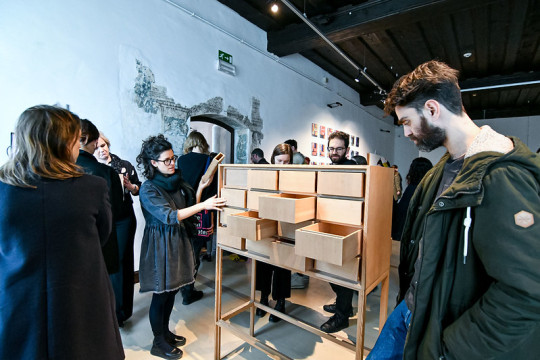

Future Architecture members have in last 4 years received 2.200 registration, among which have been selected 370 in the European Architecture Program, which consisted of 210 events with 1.300 ideas and projects. The Future Architecture platform is co-funded by the Creative Europe program of the European Union.

Call for Ideas is an invitation to register ideas and help shape the most groundbreaking architectural happenings and events that form the core of the European Architecture Program. You can apply in November and be selected to participate at the Creative Exchange in February.
Creative Exchange is the most insightful annual gathering of architecture lovers and professionals, and is held every February in Ljubljana. It brings together platform members and 25 of the most progressive emerging talents selected through the Call for Ideas.

European Architecture Program is a series of the most significant and interconnected architectural happenings and events in Europe, also featuring Architectuul’s Digital Research Fellowship.
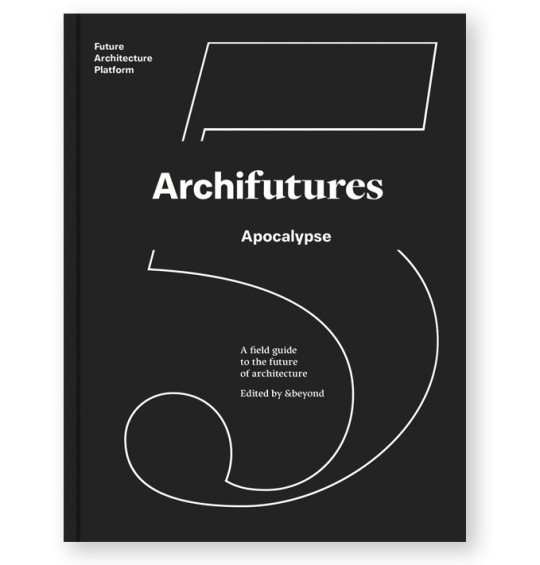
Archifutures is an innovative digital/analogue publishing hybrid that brings together the possibilities of critical editorial work, innovative printing and active user intervention.
The future is NOW! Follow it on Facebook | Instagram | Twitter.

Image credits by Creative Exchange 2020, Photo © Iztok Dimc/MAO
1 note
·
View note
Text
FURNITURE. INTERIOR. DESIGN-International Furniture, Interior and Design Exhibition at Lithuania(Vilnius) 2019-October
capital goods Exhibitors, consumer goods fairs Meetings, multi-branch trade fairs B2B Opportunities
2019, October, Kenya, Nairobi
KITE-Kenya International Trade Exhibition at Kenya(Nairobi) 2019-October
KITE-Kenya International Trade Exhibition trade show event mainly focuses on:
capital goods business opportunities, consumer goods fairs business, multi-branch trade fairs business contacts
related products/services/industry/business. This trade show opens top business opportunities to exhibit products and services from capital goods directory, consumer goods fairs Business events, multi-branch trade fairs events industry.
Find More Details about KITE-Kenya International Trade Exhibition event...
We help you to grow your business by providing the required contact details of all companies participating in this event and you can download the same data in excel format using the above links.
Location of the Event: Kenya(Nairobi)
Year-Month:2019-October
Official Website:Event Website
source https://www.expomahal.com/2019/10/furniture-interior-design-international.html
2 notes
·
View notes
Text
Atlantiss interviews Kenya Cocopeat Entrepreneur
Enterprising Kenyan Entrepreneur, James Kapombe upcycles coconut waste into valuable grow medium for farmers. 9 questions, 9 answers. He will share his journey, some tips and his future plans.

1. Share with us a brief background about yourself and your town in Kenya.
I believe being born and raised in rural Kilifi, Kenya gave me the passion for agriculture. I started with a smart farm concept to demonstrate sustainable climate smart agri-techniques but I pivoted my business model towards Cocopeat Manufacturing after identifying the pressing needs in the market.
2. What is your passion or drive to run this cocopeat manufacturing business? Was it opportunity driven or you wanted to contribute back to your towns/economy of Kenya?
I saw a gap in the market that was not being met/addressed. 99% of cocopeat was/is imported. I see this as a high potential business opportunity (including the creation of value added local jobs) for Kenya and the region.
3. Describe your jumpstart journey to embark on this business, especially on identifying, operating and maintaining the machines for your cocopeat manufacturing. Especially industrial machines may be high in capital investment and maintenance costs are unknown.
We started working on this project in August 2016, seeing how it is today, is a huge step forward. Shipping in the machinery to Kenya was very expensive and we opted to engage local engineers to develop the plant for us. It was a painful experience, because they took 5 months to deliver. In this industry, we have to be mindful that maintenance costs can sky-rocket if you use inefficient machines.
4. Who are your primary and secondary customers of cocopeat?
CocoGrow's cocopeat is mainly used by flower and vegetable growers for plant propagation. Other uses include industrial oil absorbent, mushroom substrate, pet houses, etc.
5. So, what's the benefits of cocopeat to your targeted customers? Give us your favourite pitch.
Today, one kg of tomato seeds costs more than one kg of gold. We value seeds. A seedling is the income of tomorrow. At CocoGrow, we maximise germination rate, reduce young plant mortality and ensure zero root shock during transplanting!
6. Share with us 1 or 2 tips on engaging your customers on using cocopeat. How tough was it in the beginning?
Exhibiting at the International Flower and Trade Expo (IFTEX 2018) in June before our business launch in July 2018 gave us a wider access to the market needs.
7. What major challenges and hurdles you face/faced? And how did you overcome them?
The biggest challenge was sorting out a faulty machine. We had to work around low production cycles and delays delivery time. And these are costs to CocoGrow. We need to pick up the skills and knowledge to run the machines. As we scale up the business, we recognized that the ability to supply in volumes also comes with huge working capital and physical space. Proximity to [consistent] raw materials becomes more important.
8. What are your next big plans/steps? What support and business development would you be looking for?
We have three areas to focus on: (1) Product Development, (2) Distribution Channels and (3) R&D and Machinery.
On the product front, we are currently working on various downstream products as we need to make our business sustainable and be competitive in the global market. As we scale our business, we hope to ship out to as many small-scale farmers across Africa, at cost-competitive freight rates. We also recognize the importance of Technology as we hope to work with more horticulture experts to assist us in R&D and to inject capital to upgrade our machinery.
9. Please share with us your parting, encouragement statement, to other coconut families in rural villages who may wish to embark on this journey.
Coconut is the tree of life. Everything is valuable on that tree, the tree with zero wastage. You can’t afford to be poor.
2 notes
·
View notes
Text
NICHROME INDIA AT PROPAK AFRICA

On 8th March 2022, the world's industry headed to Johannesburg to visit Propak Africa 2022. Propak Africa is Africa's leading packaging, printing, food processing, plastics and labelling trade exhibition. It’s the place to see latest innovations and technologies, packaging initiatives and cutting-edge machinery, products, consumables, systems and services.
Whether as an exhibitor or a visitor, Propak Africa offers 4 exciting days to meet knowledgeable exhibitors, network with suppliers and service providers, source cutting-edge products & technologies, and enjoy live demos, free seminars and more.
Nichrome at Propak Africa
Nichrome India was at Propak Africa, with a stall to display its offerings, network with industry representatives, and showcase its expertise in packaging.
Nichrome is already a well-known name in Africa and other parts of the world. A highly reputable packaging machine manufacturer, with its own impressive design and manufacturing capabilities, Nichrome has presence in 45+ countries of the world and over 10,000 installations. So, their participation in Propak Africa certainly helped to expand their footprint in Africa and neighbouring countries.
Nichrome and Africa
Nichrome is committed to Africa and to its industry. For the last 25 years, they have partnered with food, pharma and non-food manufacturers and marketers to enhance their packaging and retail value.
Nichrome has several achievements to their credit. They helped to successfully launch oil and drinking yogurt in flexible pouches and reintroduced milk pouches in Kenya. They have developed and installed rice plants and efficiently handled turnkey mini dairy plants in Kenya. Nichrome also introduced the penta seal pouch in Africa.
Today, they have a long list of esteemed clients and many successful projects in Africa. The aim is to go further and deeper, growing their reach and improving their support network so they can serve more and more industries across Africa.
Infinite possibilities with Nichrome
For startups, medium sized businesses or large MNCs, for existing or emerging applications, Nichrome offers infinite possibilities in packaging solutions. That too, with one-stop convenience.
With Nichrome’s strong thrust on R&D, they partner with customers, study their market and specific application, and innovate integrated solutions that deliver relevant advantages.
It could be a small variation in a pouch format or customization of an existing machine; a pro-actively developed filling system or consultancy & system design for a complete packaging plant - Nichrome has the expertise, capabilities and innovation to transform productivity and enrich customer relationships in endless ways.
Nichrome’s packaging expertise
Since Nichrome developed India's first indigenous milk packaging machine in 1977, they have been at the forefront of next-generation packaging technologies; a brand trusted for its rich legacy of pioneering innovation, extensive domain knowledge and manufacturing competency in packaging systems.
Nichrome’s expertise covers the complete spectrum of food, non-food and pharma applications. Snack packaging machine, milk packaging machine, powder filling machine, sugar packaging machine, oil filling machine, pulses & grain packaging machine, bottle filling lines, tin filling lines, mini dairy plants, tablet/capsule packaging lines, blister packaging – the list of Nichrome’s offerings can go on and on. Nichrome also offers filling systems and integrated packaging systems for a wide range of applications.
Nichrome has also partnered with renowned international companies for some technologies, especially for the Pharmaceutical sector. For enterprises big and small, for applications existing and emerging, Nichrome offers infinite possibilities in integrated, automated packaging solutions - as they partner with customers through the complete lifecycle, offering application-specific solutions, backed by dependable service and support.
Conclusion
In case you missed the Nichrome stall at Propak Africa, please contact Nichrome India directly, to discover their latest, cost-effective solutions for Africa’s industry. The leading manufacturer of packaging machines India, Nichrome has proved itself overseas as well with presence in 45 countries and more than 10,000 successful installations worldwide. So, customers in Africa or anywhere can expect top-of-the-line technology and reliable service at any location.
0 notes
Photo

2021 Zhejiang Export Online Fair (Kenya-Consumer Goods Special)
We are holding an exhibition between Kenya and China, and it is an honor to invite you to participate in our online exhibition.
As the epidemic situation has affected Kenya-China international trade, the Chinese authorities are promoting online trade fairs to promote trade between the two sides.
The name of our exhibition this time is: 2021 Zhejiang Export Online Fair (Kenya-Consumer Goods Special), the main exhibition products are daily necessities, kitchen supplies, household appliances, etc.;
We are honored to invite you to participate in the online exhibition between December 13 and 17, 2021, from 10:00 am to 11:00 am, Kenya time, and 11:00 am to 12:00 am, respectively. field.
We will participate in more than 50 exhibitors, and guests can choose the best date and time. We sincerely invite you to participate in our online exhibition, and we provide free translation services for you to communicate with Chinese exhibitors;
Looking forward to your reply
0 notes
Text
How can ISO 13485 help manufacturing companies?

ISO 13485 Certification in Sri Lanka is a global quality administration standard for makers of clinical gadgets. It determines the prerequisites for a quality framework where the producer needs to show its capacity to convey safe clinical gadgets. The essential objective of ISO 13485 is to build up a framework that is completely fit for meeting relevant legitimate and quality framework prerequisites.
Advantages of ISO 13485 for assembling organizations
· Probability of contracting with bigger organizations;
· Guaranteeing dependability and nature of the clinical gadget in various nations;
· Confirmation of consistence with lawful, administrative, legally binding, and promoting necessities;
· Exhibiting item safety to the patient/end client.
ISO 13485 is an independent norm. It depends intensely on the ISO 9001:2008 construction, and it incorporates certain particular prerequisites for clinical gadgets, for example, hazard investigation, sterile creation, modify, and recognizability. An "ISO 13485-affirmed organization" signifies an association that has executed an ISO 13485 Quality Management System (QMS) and has effectively met every one of the relevant prerequisites (thinking about the idea of the clinical gadget), evaluated by the certificate body. Peruse this article to figure out how getting ISO 13485 confirmation can profit producing organizations.
How is ISO 13485 material for assembling organizations?
ISO 13485 is proposed for any association halfway or completely engaged with the clinical gadget lifecycle, paying little mind to the association's size or type, or the sort of clinical gadget. The primary reason for an ISO 13485 Consultants in Sweden QMS is to demonstrate the maker's obligation to the wellbeing, adequacy, and execution of clinical gadgets.
Which producers are engaged with the clinical gadget lifecycle? The ones that are engaged with the accompanying cycles identified with clinical gadgets: plan and improvement, creation, stockpiling and circulation, establishment, and overhauling, just as the arrangement of related exercises (e.g., specialized help).
Plan and advancement measure. The fact of the matter is that clinical gadgets should be planned in a legitimate way to guarantee the wellbeing of patients and clients, and they should act as per their expected use. Bringing ISO 13485 into your plan and improvement cycle will direct you to characterize precisely and in detail what your info boundaries are, the means by which you will gather them, and who is answerable for each information boundary. It will likewise give you power over plan changes, so you know consistently at what stage your new clinical item advancement is.
Besides, ISO 13485:2016 expects you to guarantee recognizability all through the plan and advancement measure. ISO 13485 Services in Kenya this is significant in light of the fact that anybody can rapidly acquire understanding into what stage the plan is, look at some particular plans or hazardous components, or be fully informed regarding certain changes. Appropriately carried out recognizability permits you deftness in dealing with the plan and improvement measure.
Likewise, the ISO 13485:2016 plan and advancement prerequisites educate you to screen item chances at the absolute starting point of the plan, which altogether expands the wellbeing of the eventual outcome.
ISO 13485 requires the organization to continually audit, confirm, and approve each period of an advancement project. This guarantees that there is finished command over the improvement cycle and guarantees that the eventual outcome is protected.
ISO 13485 advantages for assembling organizations
Advantages for the organizations that carry out ISO 13485:2016 are as per the following:
· Probability of contracting with bigger organizations – numerous enormous clinical gadget organizations like to work with providers who are ISO 13485 confirmed. Enormous organizations are liable for guaranteeing that their subcontractors agree with ISO 13485, which implies that subcontractors who are as of now confirmed are probably going to have need.
· The ISO 13485 standard was made to guarantee that clinical gadgets in various nations show a similar dependability and quality. In the event that you are thinking about trading an item, ISO 13485 confirmation can give you a benefit.
· By executing ISO 13485, the association is demonstrating that it meets all relevant legitimate, administrative, authoritative, and advertising prerequisites.
· Exhibiting item wellbeing to the patient/end client – ISO 13485 teaches makers to deliver a protected item utilizing a danger based methodology. The association should dissect the whole creation measure according to the perspective of hazard to lessen hazard to a base.
How to get ISO 13485 Consultants in Thailand
We are providing Service for ISO 13485 Consultant Services in Thailand. With extensive expertise and experience in all International Restriction of Hazardous Substances Standards. For Certification and Implementation of the Standards in your organization, reach Certvalue – ISO 13485 Consultants us at +7760173623 or you can fill the form here, our experts will call you and guide for Successful Certification. Would be happy to assist your company in the ISO 13485 Certification process to send your research after [email protected].
0 notes
Text
Ngaren: The Museum of Humankind in The Great Rift Valley
The Museum of Humankind, The Great Rift Valley Building Project, Kenya Architecture Design
The Museum of Humankind in The Great Rift Valley
Public Building Development in Kenya, East Africa design by Studio Libeskind Architects
25 Sep 2020
Ngaren: The Museum Designed to Revolutionize Travel to Kenya, Post Covid-19
Dr. Richard Leakey’s plans for a new museum dedicated to the story of humankindaims to revolutionize travel to Kenyain the post pandemic world.
Ngaren: The Museum of Humankind,being built in Kenya’s Rift Valley,a region synonymous with human origins, is the culmination of Dr. Leakey’s life’s work –whose fossil discoveries have helped reveal how humans evolved. The museum will be the first of its kindoffering a life-changing experience, an educational day out, social interaction, and stimulation of all senses.
Ngaren will allow visitors to explorehuman origin and evolution from a scientific perspective, in the context of the natural processes and serendipitous events that led to the survival of Homo sapiens as the only human species alive today. The project aims to contribute to the development of Kenya by creating, teaching and promoting education, science, sustainability, and equality,and attract visitors from near and far bolstering economic development to the region.
The Great Rift Valley is one of Kenya’s top tourism destinations – a “must see” for its breathtaking natural scenery and iconic wildlife, including rhinos, African elephants, and the world’s greatest concentration of flamingos in Lake Nakuru. The valley is also the location of some of the most important paleo-anthropological discoveries ever made and the Leakey family, known for their unprecedented discoveries of hominin remains, has spent decades uncovering evidence of the mysteries of human evolution in East Africa and the Rift Valley. The RiftValley is therefore the perfect environment to represent the evolution of humankind in a brand-new museum built to celebrate the African origins of all humanity.
Already, Dr. Leakey’slife’s work has contributed greatly to the improvement of the environment and sparked a worldwide movement to end the ivory trade. Today, Richard who followed in his parents Mary and Louis Leakey’s footsteps studying human evolution, remains as passionate about humanity, as he is about evolution, all life on earth and biodiversity.
Withthe development of Ngaren, at the age of 75, the Kenyan conservationist and paleoanthropologist is still full of dreams and hope for humanity’s future. But he is also worried: “We somehow think that we as humans are a special creation, that the rulesthat conservationists are worried about don’t apply to us. But they apply tous just as much, if not more, than to anything else that is living today. We aredestroying the bees, their ability to pollinate plants, we are destroying theplants themselves by raising temperatures so they cannot produce nutritiousfood, we are pouring carbon-dioxides into the oceans, making the oceansacidic until their whole food chain is collapsing,” says Dr. Leakey.
In honor and celebration of his family’s discoveries of fossils and early hominins, and as a call to action to all of us who share this planet we call home, Richard has commissioned the establishment of the iconic museum that will be built on a piece of land he and his wife Maeve donated.
Ngaren, Leakey explained, “represents a celebration of the beginning of all humanity; of life and its amazing biodiversity. It is dedicated to educating humankind on our shared past, and tells the story of our common ancestry, our epic journey of evolution”.
The state-of-the-art museum’smasterplan is being developed in collaboration with Naturalis Biodiversity Center | Museum and Research. Ngarenwill have the only all-digital Planetarium in Africa andwillbe the only African museum to display real-size African dinosaurs. Using innovative technologies and museology, interactive exhibits and educational experiences are being designed for visitors of all ages, to teach and promote science, critical thinking, andimagination. Ngaren will bring visitors face-to-face with real life issues, our human impacts on the climate and planet, as well as help us to understand our obligations in sustaining it.
The project comes at a time when the world is grappling with the Covid-19 pandemic.
As everywhere else in the world, the social and economic impacts of the Covid-19 pandemic in Kenya have been devastating. The travel and tourism industry have suffered a huge blow as countries locked down, airlines grounded, hotels closed, and stringent travel restrictions enacted. At the end of 2019, international visitor arrivals toKenya remained above twomillion, with a 1.167% increase from 2018. However, available data showsan averagereduction of above 50% in 2020, translatinginto a loss of over 65million international arrivalsas the pandemic continues to sting.
Despite the challenges, the Ministry of Tourism in Kenya is focused on a post-Covid strategy, that will ensure a shorter recovery period for the industry. Besides strengthening domestic and regional tourism to re-rebuild tourists’confidence, the ministry has further proposed “strong mutually beneficial partnerships that will drive sustainable value, growth and impact for destination Kenya”.
Ngaren, whose groundbreaking is expected to be in 2022 and opening in 2026, is expected to help stabilize Kenya’s tourism by attracting visitors to the Ngaren campus which will house the Ngaren museum, partner institutions, a restaurant, conference rooms, and a small amphitheater to host venues of different sorts – social, business, and family gatherings.
With plans to welcome a million visitors, both international and domestic, every year, the ripple effect will be highly impactful to related industries including travel, hospitality and MICE (Meetings, Incentives, Conferences and Events).
The Ngaren Museumwill be a top historic educational site for institutions both in Kenya and abroad. The project is expected to create thousands of jobs and place Kenya in the global map as a preferred museum and paleo-tourism destination, a sector that remains largely untapped in the region.
In addition, the East African Museum of Art (Nairobi) [EAMAN] has announced that it will join the Ngaren Museum on the Ngaren campus in the Rift Valley. When built, EAMAN will be the first museum telling the story of Eastern African art from the dawn of human civilization to our times in a rich, contextualized, and innovative way.
It will be a world class cultural institution dedicated to the collection, preservation, study, and sharing of the most outstanding manifestations of Eastern African art. Through first rate curatorial and scholarly work, EAMAN will strive to be the global leader in nurturing and promoting the understanding of and appreciation for Eastern African art. Collections and exhibitions of EAMAN will be made widely accessible to people of Africa as well as to visitors, students, and scholars from every part of the world – both physically and digitally.
The Ngaren Museum has been described as “lieu de memoire”, meaning a site of memory. Through a series of interactive, cutting-edge exhibition spaces, Ngarenwill unravel the mysteries of our beginnings. “It is not just another museum, but a call to action” says Dr. Richard Leakey, founder. “As we peer back through the fossil record, through layer upon layer of long extinct species, many of which thrived far longer thanthe human species is ever likely to do, we are reminded of our mortality as a species”. The museum is scheduled to open in 2026.
Previously on e-architect:
26 June 2020 ; 14 May 2019
Ngaren in The Great Rift Valley
Design: Studio Libeskind
Location: The Great Rift Valley, Kenya, East Africa
Ngaren: The Museum of Humankind Launches Fundraising Campaign on May 13, 2019, at the Princeton Club, New York City
Dr. Richard Leakey announces the campaign for a new museum dedicated to the story of humans, Ngaren: The Museum of Humankind. The unprecedented project located in Kenya’s Rift Valley is designed by architect Daniel Libeskind, Studio Libeskind, the master plan architect of the World Trade Center site.
Ngaren is the culmination of Dr. Leakey’s life’s work –whose fossil discoveries have helped reveal how humans evolved. The Museum will be the first center of its kind to present research, discovery, and exploration of more than two million years of human history and the origins of our universe from evolution, biodiversity, overpopulation, to war, disease, and climate change.
“Ngaren is not just another museum, but a call to action,” says Dr. Richard Leakey, Founder. “As we peer back through the fossil record, through layer upon layer of long extinct species, many of which thrived far longer that the human species is ever likely to do, we are reminded of our mortality as a species,” added Leakey.
Dr. Leakey commissioned Studio Libeskind to create an iconic design that reflects the mission and values of the Museum. Sited on the edge of a cliff overlooking the Rift Valley—the cradle of humankind and where Leakey first discovered the most complete skeleton of early man, Turkana Boy.
The design is inspired by the forms of ancient hand axes that were the first tools of early man marking the beginnings of human ingenuity. The monolithic volumes rise like vertical stalactite set against the dramatic landscape of greater Nairobi in Loodariak. Through a series of interactive, cutting-edge exhibition spaces, Ngaren will unravel the mysteries of our beginnings.
“The museum will be a place for discovery, wonder, and contemplation. Through the architecture and exhibitions, Ngaren will anchor all walks of life to Africa: the epicenter of human existence,” said architect Daniel Libeskind. “I created a series of dramatic spaces within the museum that are architecturally dynamic and provocative, creating a unique context for the museum’s exhibitions that does not pacify artifacts, but enhances and enlivens them,” added Libeskind.
The museum is scheduled to open in 2024 in Loodariak, Kenya. Studio Libeskind, working with local Kenyan architects, is the lead architect for the design and construction of the museum.
For more information the public may visit www.ngaren.org
About Ngaren
The Museum of Humankind Founded by Dr. Richard Leakey, Ngaren is a historic collaboration to create a center that explores the science behind climate change and celebrates the evolutionary processes that shape us. The mission is to create a worldclass Museum that will stand as a monument to science, education, social and climate action and connect the African legacy to all humans worldwide. Headquartered in the Rift Valley, Kenya and New York, Ngaren has gathered the best and brightest minds to realize this vision.
About Founder, Dr. Richard Leakey
Dr. Richard E. Leakey is an award-winning Kenyan paleoanthropologist,conservationist, and politician. The son of renowned scientists Louis and Mary Leakey, he has held a number of official positions in Kenya. Leakey has been Director of the National Museum of Kenya and head of the Kenyan Wildlife Service, and founded the NGO WildlifeDirect, as well as the Turkana Basin Institute –a research institution supporting scientific projects in human prehistory, sustainability, climate change, and modern human culture and diversity in Northern Kenya.
Board of Directors
Richard E. Leakey, Founder
Sarah Ferguson, The Duchess of York
Henry Louis Gates, Jr.
John Heminway
Rachel Mbai
Scott Miller
Marta Mirazon Lahr
Ellen C. O’Connell, Chief Executive Officer
Tony Saxton
Annette Williamson
About Studio Libeskind
Studio Libeskind is an international architecture practice headquartered in New York City. The studio is involved in designing and realizing a diverse array of urban, cultural and commercial projects internationally. The Studio has completed buildings that range from museums and concert halls to convention centers, university buildings, hotels, shopping centers and residential towers.
Daniel and his partner Nina Libeskind established Studio Daniel Libeskind in Berlin, Germany, in 1989 after winning the competition to build the Jewish Museum Berlin. In February 2003, Studio Daniel Libeskind moved its headquarters from Berlin to New York City when Studio Libeskind was selected as the master planner for the World Trade Center redevelopment.
Ngaren: The Museum of Humankind in The Great Rift Valley image / information received 140519
Daniel Libeskind Architect
Location: Kenya, Africa
African Buildings
Africa Architectural Projects
African Architecture Designs – chronological list
African Architecture News
Dakar Railway Station, Senegal, western Africa
Design: Iglo Architects
image from architects
Joali Resort, Muravandhoo Island, North Maldives
Interior design: Autoban
photo from Guralla
Joali Resort on The Maldives
Daniel Libeskind Architects
New Architecture in Africa
African Buildings
Pediatric Cancer Centre, Kigali, Rwanda
Architects: David Adjaye – Adjaye Associates
image Courtesy architecture office
Pediatric Cancer Centre in Kigali
Oceans Paradise, Hulhumale, the Maldives
Design: CAA (Core of Architecture & Art) Architects
image Courtesy architecture office
Maldives Airport Economic Zone Mixed-use Development
Comments / photos for the Ngaren: The Museum of Humankind in The Great Rift Valley – African Architecture page welcome
Website: Kenya
The post Ngaren: The Museum of Humankind in The Great Rift Valley appeared first on e-architect.
0 notes
Photo










International Tea Day
International Tea Day is an annual feast celebrated on December 15. Is there anything that will make the snowy chill winter season into a warmer climate other than a cup of tea? Of course, nothing can stand in front of the tea, and no other beverages can make you feel the warmth. Tea is the most popular drink from all over the world and is usually served hot. Having a tea kettle in hand and sipping it would never be compensated by any other drink. International Tea Day is observed as to draw the attention of government and public about the problems besetting the tea production and how tea plantations, small tea growers and consumers are being affected by the global tea trade. Hence, it is not yet another Day to excuse yourself to have a cup of tea rather it is a Day to think about the problems faced by the tea plantation and the impacts of the global tea trade.
“Tea, though ridiculed by those who are naturally coarse in their nervous sensibilities will always be the favorite beverage of the intellectual.” – Thomas de Quincey
History of International Tea Day
In the year 2005, the International Tea Day was first observed. Since then, the Day is celebrated in the tea producing countries from all over the world. It includes Bangladesh, India, Indonesia, Kenya, Malaysia, Malawi, Nepal, Sri Lanka, Tanzania, Uganda, and Vietnam. Although the idea for establishing this Day existed for many years, it was not made into an action earlier to 2004. Once after the initial discussions held at the World Social Forum in 2004, the first observance of the International Tea Day was celebrated in New Delhi in the year 2005. It was organized in Sri Lanka in the following year and in 2008. The trade union movements have jointly organized the celebration Day and the related Global Tea Conferences.
International Tea Day aims in raising the global attention of governments and citizens about the impacts of the global tea trade. The Day also brings out the problems faced by the workers and growers. With the observance, the Day also aims in linking the requests for the price supports and fair trade. The impact of the global tea trade falls on the workers of the tea plantations, small producers and the consumers. The Indian government in 2015 had proposed expanding the observance of this Day through the UN Food and Agriculture Organization. With the World Trade Organization commodity policies, world trade in tea is beholding some significant changes. Under the compulsions of WTO, the structure of the global tea trade commodity provides an absolute advantage to both the transnational brands and the retailers in the trade.
With WTO compulsions, the elimination of tariff and importing tea from other countries would largely diminish the commodity rates of the tea in the producing countries. All these have made a situation where without increasing the demand for tea, global commodity prices have been pushed further downwards. As a result, tea gardens get abandoned. Thus enabling the global brands to purchase tea at the lowest possible prices. It is a perfect Day for anyone who loves tea to show your gratitude and appreciation to those people who are involved in planting, processing and delivering this excellent beverage to all the people globally.
How to Celebrate International Tea Day
Celebrating the International Tea Day is quite simple. Firstly you have to drink a cup of tea with your friends and family. You can add some ginger, cinnamon to make it tastier. Next, you can discuss the problems faced by the tea plantations, producers, and consumers. Participate in various exhibitions conducted by the ITD as a form of dedication to tea and gather useful information. You can even take a visit to the nearest hill station where tea is grown. Ask the people who are working there about their problems. Tell people around you about your visit to the tea plantation and the information you have gathered.
Source
#International Tea Day#InternationalTeaDay#Ottawa#Ontario#Canada#Women are Persons By Barbara Patterson#I don't like coffee#I love tea#USA#restaurant#original photography#Tropical Ice Tea#always unsweetened#Peach Green Tea#Malaysian Ice Tea#Lavender Ice Tea#Spiked Texas Tea#don't drink and drive#Jack's Dundee Tea#Strawberry White Tea#coffee shop#travel#vacation
4 notes
·
View notes
Text
Atwoli’s Speech during Labour Day 2020 at State House
New Post has been published on https://newscheckz.com/atwolis-speech-labour-day-2020-state-house/
Atwoli’s Speech during Labour Day 2020 at State House
May 1, 2020May 1, 2020
His Excellency The President and Commander In-Chief of the Defense Forces of the Republic of Kenya Hon. Uhuru Kenyatta, C.G.H.
The Cabinet Secretary Ministry of Labour & Social Protection Hon. Simon Chelugui, CBS
The Chief Administrative Secretary, Ministry of Labour & Social Protection Hon. Patrick Ole Ntutu
The Principal Secretary of Labour, Eng. Peter Tum, OGW,
Honourable Cabinet Secretaries Present
Executive Director, Federation of Kenya Employers, FKE Sis. Jacqueline Mugo, MBS, OGW
PROLOGUE
• Foremost Your Excellency, let me take this rare opportunity to congratulate you for your exceptional acceptance immediately we wrote inviting you to preside over the 55th International Labour Day Celebrations at Uhuru Park.
YouTube
LABOUR DAY 2020: COTU Secretary General Francis Atwoli’s full speech
• Fortunately, here you are Your Excellency and let me recognize the fact that throughout your presidency, you have stood with workers and at no one time have you left workers to be on their own. Thank you Your Excellency.
• Let me also congratulate all Kenyan workers together with their families on this occasion of the 55th International Labour Day.
• This year’s Labour Day will be remembered for many years to come given the difficult and challenging global health circumstances under which it is being communicated without celebrations.
• We pay our special tribute to all those workers who have lost their lives to the Coronavirus Pandemic and for those who have tested positive and hospitalized, we wish you quick recovery.
• For the first time in our long history, Labour Day world-over is taking place behind closed doors with limited participation of government, workers, employers including the general public owing to the insurgence of the Corona Virus Disease (COVID-19) which came as a mysterious intruder into the world of work.
WORK PLACES
• However, this Pandemic is no coincidence; God is sending us a message that after days of
YouTube
LABOUR DAY 2020: COTU Secretary General Francis Atwoli’s full speech
weeping, and if we listen to him and continue praying, there shall be joy but only if we can as a people change our general feelings towards humanity that might have angered our Almighty God.
THANK GOVERNMENT
• Your Excellency, allow me on behalf of millions of Kenyan workers, locally and abroad, to commend you and your government for the stringent measures that you have put in place to mitigate the negative effects of the virus and also your able Cabinet Secretary for Health Hon. Mutahi Kagwe for the good job he has so far exhibited together with his team.
• Indeed this shows your total commitment to save this nation, you mean well for Kenyans, Your Excellency.
• Let me also take this moment to thank those employers who have kept workers in full employment despite the pandemic and particularly those who have gone ahead to enter into separate agreements with their respective unions to ensure no worker losses employment as per your directive Your Excellency.
• We thank the Landlords as well particularly those who have accepted and allowed their tenants to stay either on half rent or without paying rent at all as they (Landlords) express their solidarity with the government.
• COTU(K)’s special thanks as well goes to our medical personnel, our Doctors, Nurses, Clinical Officers, Lab technicians, cleaners in our health facilities, Police Officers among others who have all put their lives on line for the sake of Kenyans affected by this pandemic. Truly we can’t thank you enough. May God Bless You All.
• Let me also appreciate the important role that the various companies across the country have played in terms of supply of face masks and other related equipments in mitigating the Pandemic.
ECONOMIC PERFORMANCE
• Your Excellency, no doubt as a country just like the rest of the Global Community, we expect an unprecedented economic meltdown that will see a slow performance in the world economy but we promise to join hands with both the government and employers to examine the post corona virus period and we are optimistic that with the strong solidarity we have today, we will rebuild our economy in the shortest possible time.
• Meanwhile, we wish to thank particularly those leaders that have stood with you Your Excellency side by side as you steer this country to greater heights; we are also alive to the Agenda we had prior to this pandemic and it must succeed for our prosperity as a Nation.
BUILDING BRIDGES INITIATIVE
• On a day like this in 2017, Your Excellency we proposed to Kenyans to accept to review our constitution particularly in the area of governance which has been a source of political troubles, misunderstandings and violence. When problems occur, it is workers, women and children who suffer.
• We are glad that this agenda was finally mooted out of the famous handshake and dubbed Building Bridges Initiative that aims at relooking at our Constitution afresh.
• As Trade Unions and workers, we have already submitted our memorandum to the BBI team with regard to this demand and we are proposing a change in our governance structure where we have a President, a Vice President, a Prime Minister with two Deputy Prime Ministers and Cabinet Ministers to be appointed among the elected Members of Parliament so that our August House can have ministers within who can answer questions and defend government policies on behalf of the Kenyan people.
SALARIES AND REMUNERATION COMMISSION, (SRC)
• As workers Your Excellency, we are deeply concerned with the manner in which the, SRC is exercising its role.
• The Commission has deliberately continued to interfere with all Collective Bargaining Agreements, CBAs that the Unions have freely negotiated with the Employers especially those affecting parastatals and related government agencies.
• While the SRC role was to advise as per our 2010 Constitution, the Commission has since abdicated this role and usurped the responsibilities of social partners under tripartism arrangements to negotiate for salaries and fix wages and allowances for Workers without consulting social partners.
• This move Your Excellency by the Commission is in total contravention of our own legislations governing employee/ employer relations as well as the International Labour Organization, Conventions 87 and 98.
• Indeed we are optimistic that through the BBI Initiative, the SRC will be disbanded and removed from the list of Independent Commissions since Kenya boasts of a robust economy and a competitive business environment that is capable of regulating itself through its own market forces if we can tame corruption.
TOM MBOYA LABOUR COLLEGE, KISUMU
• Your Excellency, in our efforts to transform the Tom Mboya Labour College, Kisumu to a world class institution that can offer training for workers locally and globally, COTU (K) has embarked on its renovation work that is half-way complete and now on halt due to the current Coronavirus Pandemic.
• We have since spent over Kshs. 120,000,000 (Kshs.120M) on this work from our own internal sources and whereas I wish to thank the Government for its earlier support in financing the first Phase of the College’s Resource Centre, we are optimistic that your government will consider completing the second and last Phase of this important Centre for workers’ education since an educated worker creates stability and industrial peace at work place.
NATIONAL SOCIAL SECURITY FUND, NSSF
• Your Excellency, let me thank your government for the tremendous support it has given to the Board of Trustees and Management at NSSF in protecting workers’ funds.
• Today, the Fund now boasts of a Kshs. 300 Billion portfolio in assets and cash at hand and this growth has been as a result of your personal intervention in ensuring that there is no political interference in the running of the Fund.
• You exhibited this when you reorganized the Ministry of Labour because of NSSF in 2015.
• However, Your Excellency, we are concerned over the numerous attempts by individual politicians to amend the NSSF Act of 2013 so that they can remove both FKE and COTU (K) from the Board of Trustees for their own selfish ends and we call for your intervention to continue protecting these funds.
NATIONAL HOSPITAL INSURANCE FUND, NHIF
• Your Excellency, let me thank you and your government for the appointment of a new Chief Executive Officer at the NHIF.
• As workers, we call on the new CEO to remain firm and not fall victim to politicians who are out to loot the NHIF as they did under the previous CEO and to the period preceding 2017 elections.
• We are ready to extend our support to the new CEO in ensuring that he discharges his duties without any political interference and mismanagement.
REPOSSESSION OF GRABBED PARCELS OF LAND
• Your Excellency, we thank you and your government for the bold step you have taken to repossess any grabbed land in the country particularly the recent move to repossess the Ruai Sewerage Land.
• This has send a very strong message to all those grabbers and those who occupy grabbed land across the country that it is just a matter of time that their ill-gotten parcels of public land will revert back to the rightful owners who are the Kenyan people.
• We urge your government not to relent in these efforts as the entire Kenyan citizens are behind you.
ORGANISATION OF AFRICAN TRADE UNION UNITY, OATUU
• Your Excellency, as the President of our Pan-African Organisation of African Trade Union Unity, OATUU let me take this opportunity on behalf of the workers on the continent to humbly thank you and your government for the commitment to contribute an annual Grant of USD. 200,000.
• We are pleased to inform you, Your Excellency, that already the first contribution of USD. 200,000 is in the process of being transferred to the organisation and once it is received, we will equally inform you. We thank you; Your Excellency.
MINIMUM WAGE
• Your Excellency, we thank you for the so many cautionary measures you have taken to cushion workers on the cost of living and other hardships including food to the workers who are facing numerous difficulties during this period of Coronavirus pandemic.
• However, Your Excellency we appeal to you that as you continue to protect us from this Pandemic, consider extending your offer to workers for tax exemptions from Kshs. 24,000 that you gave us up to Kshs. 100,000 as this will go a long way in cushioning most of the lowly placed Kenyans and any other support you may deem fit as a worker number one.
• We will continue to support you despite these difficult times we find ourselves in and we are now afraid and unable to make any demands for a Minimum Wage increase as we have always done.
• However, for now we want to thank you for the various measures you continue to take to assist workers both logistically and financially in mitigating the effects of Coronavirus and don’t get tired on the same.
• I thank you.
0 notes
Video
undefined
tumblr
CMC MOTORS GROUP LIMITED, KENYA at Buildexpo Kenya 2019 displaying different Trucks. The event is East Africa's Prime international trade exhibition on building and construction products held in Kenya.
https://www.cmcmotors.com/
Visit https://www.expogr.com/buildexpokenya/ to know more about the 23rd Buildexpo Kenya 2020.
0 notes
Text
Everything about Indian e business visa

Having an Indian business visa means you can travel to India and stay here for a fixed period of time to know its business atmosphere much better so that you can set up your own business here and recruit eligible employees for your business.
India is not only known for its vast culture, historical buildings, delicious delicacies and the like, but it is also known for being a country whose vast portion is the young and most of them are capable of speaking and understanding English and some other foreign languages. Such reasons compel a large number of foreigners to set up their own company in this fast-growing country. Indian Visa helps you to find hassle free Indian E Visa.
The business visa for India is always in high demand, which is why the government of India has made it hassle-free; you can apply for and receive an Indian business visa online. The electronic Indian business visa is also known as the e-business visa for India can allow you to represent your business before Indian companies to make or bolster professional relationships with them to expand your business.
So, read this article thoroughly to know everything about the Indian e-business visa.
Benefits of Indian e-business visa:
The following are Indian e-business visa advantages, you can do the following things if you hold this visa:
You can have business or workshop meetings.
You can start a business or industrial venture.
You can attend and give lectures under GIAN (Global Initiative for Academic Network).
You can find and hire eligible employees from India.
You can fulfill your trade, sales and purchase purposes.
You can attend exhibitions, business or trade fairs.
Eligible countries for business e visa for India:
The following is a list of those countries whose citizens can apply for the e-business visa for India. If you are not a citizen of any of countries given below in alphabetical order, then you can’t apply for this visa:
Albania
Andorra
Angola
Anguilla
Antigua & Barbuda
Argentina
Armenia
Aruba
Australia
Austria
Azerbaijan
Bahamas
Barbados
Belarus
Belgium
Belize
Benin
Bolivia
Bosnia & Herzegovina
Botswana
Brazil
Brunei
Bulgaria
Burundi
Cambodia
Cameroon
Canada
Cape Verde
Cayman Island
Chile
China
China- SAR Macau
Colombia
Comoros
Cook Islands
Costa Rica
Cote D'Ivoire
Croatia
Cyprus
Czech Republic
Denmark
Djibouti
Dominica
Dominican Republic
East Timor
Ecuador
El Salvador
Eritrea
Estonia
Fiji
Finland
France
Gabon
Gambia
Georgia
Germany
Ghana
Greece
Grenada
Guatemala
Guinea
Guyana
Haiti
Honduras
Hong Kong
Hungary
Iceland
Indonesia
Ireland
Israel
Italy
Jamaica
Japan
Jordan
Kazakhstan
Kenya
Kiribati
Kyrgyzstan
Laos
Latvia
Lesotho
Liberia
Liechtenstein
Lithuania
Luxembourg
Macedonia
Madagascar
Malawi
Malaysia
Mali
Malta
Marshall Islands
Mauritius
Mexico
Micronesia
Moldova
Monaco
Mongolia
Montenegro
Montserrat
Mozambique
Myanmar
Namibia
Nauru
Netherlands
New Zealand
Nicaragua
Niger Republic
Niue Island
Norway
Oman
Palau
Palestine
Panama
Papua New Guinea
Paraguay
Peru
Philippines
Poland
Portugal
Qatar
Romania
Russia
Rwanda
Saint Christopher And Nevis
Saint Lucia
Saint Vincent And The Grenadines
Samoa
San Marino
Saudi Arabia
Senegal
Serbia
Seychelles
Sierra Leone
Singapore
Slovakia
Slovenia
Solomon Islands
South Africa
Spain
Sri Lanka
Suriname
Swaziland
Sweden
Switzerland
Taiwan
Tajikistan
Tanzania
Thailand
Tonga
Trinidad And Tobago
Turks And Caicos Isl
Tuvalu
Uganda
United Arab Emirates
United Kingdom
Uruguay
USA
Uzbekistan
Vanuatu
Vatican City - Holy See
Venezuela
Vietnam
Zambia
Zimbabwe
E business visa India requirements:
The following are the Indian e business visa requirements. Read them before you go for an Indian business visa application online.
Your passport must have at least six-month validity from your arrival date in India.
Your passport must have two blank pages so that officials can place entry and exit stamps.
You must carry the same passport used while applying.
You must be financially stable to fulfill your financial requirements during your stay in India.
Every applicant must be in possession of an individual passport.
You need to answer some questions related to the companies sending or receiving you in India.
Indian e business visa documents:
The following are the documents required for e-business visa for India:
You need to provide a clear and coloured scanned copy of your passport in JPG, PDF or PNG format that mustn’t be over 3 MB of size.
You need to be in possession of a Business card/Visiting card or a letter from the company that specifies your travel purpose.
You need to give any latest passport-sized photograph of yours. It must have a white background so that everything can be clearly visible, and its size mustn’t be more than 3MB.
A yellow fever vaccination card if coming from a yellow fever affected country.
Indian e business visa validity:
Indian e-business visa rules were updated on 18 March, 2019 by the Government of India for all eligible countries. The validity of Indian e-visa for business is 365 days from the issuance date, and you can have multiple entries, which will allow you to expand your business in India conveniently. You can stay in the country for up to 180 days at a stretch. If you want to stay for more than 180 days, then you need to get registered with FRRO/FRO concerned within a two-week period when your 180 days are expired.
Indian e-business visa processing time:
Innumerable applicants apply for an Indian business visa online, in spite of that the processing time for e-business visa for India doesn’t take much time and you can get it before the usual time by applying for urgent e-visa. To understand it better, take a look at the processing time and duration for both normal and urgent visas given below:
Normal processing:
Normal processing takes between 4 and days to get an e-business visa. You can apply for the normal e-visa by choosing ‘Normal processing’’ which is given under the column of ‘Application Type’.
Urgent processing:
You can get an urgent e-business visa for India within 24 to 72 hours. So, you’d better apply at least 72 hours before your travelling date. You need to select ‘Urgent Processing (within 72 hours) in the application form for applying for an urgent e-business visa.
Entry ports with Indian e-business visa:
An e-visa holder can enter India through 28 designated airports and 5 designated seaports whose details are given below:
International Airports:
Ahmedabad, Amritsar, Bagdogra, Bengaluru, Bhubaneshwar, Calicut, Chennai, Chandigarh, Cochin, Coimbatore, Delhi, Gaya, Goa, Guwahati, Hyderabad, Jaipur, Kolkata, Lucknow, Madurai, Mangalore, Mumbai, Nagpur, Port Blair, Pune, Tiruchirappalli (Trichy), Trivandrum (Thiruvananthapuram), Varanasi and Vishakhapatnam
Seaports:
Chennai, Cochin, Goa (Mormugao), Mangalore, Mumbai
Conclusion
In this informative article, we told you about the Indian business visa. Having read this whole blog, you must have a crystal-clear idea of documents required for Indian e-business visa, eligible countries, processing time, validity and entry points.
If you have anything to ask or know regarding the e-business visa for India, then feel free to contact us.
0 notes